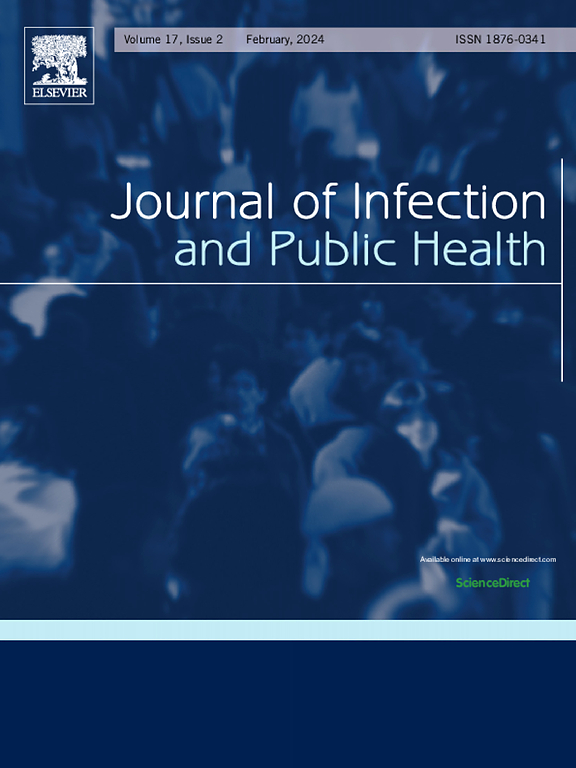量化韩国后covid -19流行阶段的社会接触动态:传染病传播的横断面调查
IF 4.7
3区 医学
Q1 INFECTIOUS DISEASES
引用次数: 0
摘要
了解社会接触模式的动态对于建立传染病传播模型至关重要。尽管以前的研究已经在全球范围内对它们进行了检查,但它们与流行阶段的社会模式的相关性仍不清楚。韩国独特的文化规范、人口老龄化和生育率下降凸显了对新数据的迫切需求。在这里,我们的目标是在韩国进行接触调查,提供年龄和特定地点的接触估计,并量化与传染病传播相关的模式。方法我们于2023年7月6日至9月5日在韩国进行横断面调查。所有年龄段的参与者都是在2023年人口普查的基础上使用配额抽样招募的,每个家庭只包括一个人。社会交往,包括身体上的和非身体上的,通过24小时的日记记录下来。采用负二项回归模型对数据进行分析。使用基于人口普查的采样权来构建特定年龄的接触矩阵,并通过自举来评估不确定性。结果1493名参与者(男性740名,女性753名)报告接触14187次,平均每天接触9.2次(95 %置信区间[CI]: 8.7-9.8)。5-9岁儿童的接触次数最高为17.8次(95 % CI: 14.6-21.5), 75岁及以上儿童的接触次数最低为3.5次(95 % CI: 2.6-4.5)。儿童和青少年的群体接触率更高,大多数接触发生在工作场所或教育机构。所有年龄组的家庭联系水平都有所增加。结论:我们确定了韩国不同的社会接触模式,例如同伴群体之间的高度互动,这表明需要以学校为基础的疫苗接种计划,以家庭为中心的策略和工作场所感染控制措施。这些发现为加强疾病建模提供了关键的基线数据,并为韩国和其他文化背景下的专业公共卫生政策制定提供了信息。本文章由计算机程序翻译,如有差异,请以英文原文为准。
Quantifying social contact dynamics in South Korea in the post-COVID-19 endemic phase: A cross-sectional survey for infectious disease transmission
Background
Understanding the dynamics of social contact patterns is crucial for modeling the spread of infectious diseases. Although previous studies have examined them globally, how relevant they are to social patterns in the endemic phase is still unclear. South Korea’s distinct cultural norms, aging population, and declining fertility highlight the critical need for new, context-specific data. Here, we aim to conduct a contact survey in South Korea, providing age and location-specific contact estimates and quantifying patterns related to infectious disease transmission.
Methods
We conducted a cross-sectional survey in South Korea from July 6 to September 5, 2023. Participants of all ages were recruited using quota sampling based on the 2023 census, with only one individual per household included. Social contacts, both physical and non-physical, were recorded through a 24-hour diary. The data were analyzed with a negative binomial regression model. Age-specific contact matrices were constructed using census-based sampling weights, with uncertainty assessed through bootstrapping.
Results
A total of 1493 participants (740 males and 753 females) reported 14,187 contacts, with an average of 9.2 daily contacts (95 % confidence interval [CI]: 8.7–9.8). Contacts peaked at 17.8 (95 % CI: 14.6–21.5) among children aged 5–9 and were lowest at 3.5 (95 % CI: 2.6–4.5) for those aged 75 and above. Children and teenagers had a higher rate of peer-group contact, with most contacts occurring in workplaces or educational institutions. The level of family contact increased across all age groups.
Conclusion
We identified distinct social contact patterns in South Korea, such as high interactions within peer groups, which suggest the need for school-based vaccination programs, family-centered strategies, and workplace infection control measures. These findings provide critical baseline data to enhance disease modeling and inform professional public health policy development in South Korea and other cultural contexts.
求助全文
通过发布文献求助,成功后即可免费获取论文全文。
去求助
来源期刊

Journal of Infection and Public Health
PUBLIC, ENVIRONMENTAL & OCCUPATIONAL HEALTH -INFECTIOUS DISEASES
CiteScore
13.10
自引率
1.50%
发文量
203
审稿时长
96 days
期刊介绍:
The Journal of Infection and Public Health, first official journal of the Saudi Arabian Ministry of National Guard Health Affairs, King Saud Bin Abdulaziz University for Health Sciences and the Saudi Association for Public Health, aims to be the foremost scientific, peer-reviewed journal encompassing infection prevention and control, microbiology, infectious diseases, public health and the application of healthcare epidemiology to the evaluation of health outcomes. The point of view of the journal is that infection and public health are closely intertwined and that advances in one area will have positive consequences on the other.
The journal will be useful to all health professionals who are partners in the management of patients with communicable diseases, keeping them up to date. The journal is proud to have an international and diverse editorial board that will assist and facilitate the publication of articles that reflect a global view on infection control and public health, as well as emphasizing our focus on supporting the needs of public health practitioners.
It is our aim to improve healthcare by reducing risk of infection and related adverse outcomes by critical review, selection, and dissemination of new and relevant information in the field of infection control, public health and infectious diseases in all healthcare settings and the community.
 求助内容:
求助内容: 应助结果提醒方式:
应助结果提醒方式:


